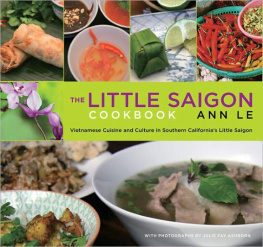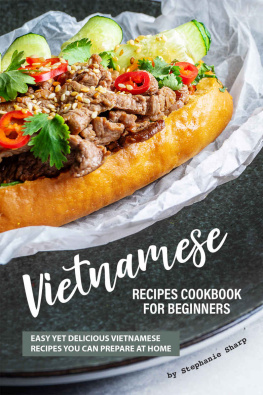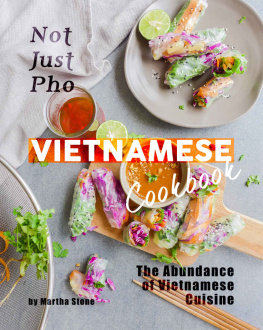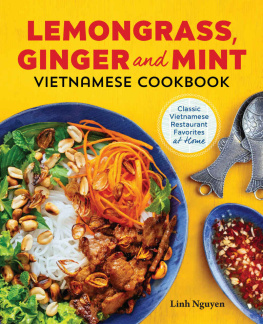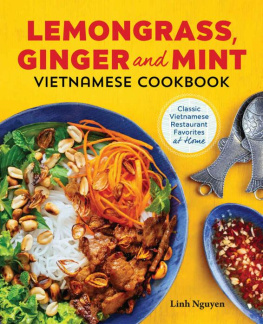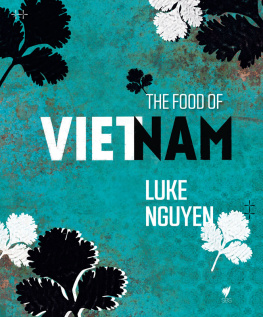Table of Contents

To buy books in quantity for corporate use
or incentives, call (800) 962-0973, ext. 4551,
or e-mail premiums@GlobePequot.com.
INSIDERSGUIDE
Copyright 2006 by Ann Le
All rights reserved. No part of this book may be reproduced or transmitted in any form by any means, electronic or mechanical, including photocopying and recording, or by any information storage and retrieval system, except as may be expressly permitted by the 1976 Copyright Act or by the publisher. Requests for permission should be made in writing to The Globe Pequot Press. P.O. Box 480, Guilford, Connecticut 06437
Insiders Guide is a registered trademark of Morris Book Publishing, LLC.
ThreeForks is a trademark of Morris Book Publishing, LLC.
Text design by Nancy Freeborn
Maps by Multimapping Ltd. Morris Book Publishing, LLC.
Photo credits: pp. viii. xi. and 96 courtesy Ann Le: pp. 145 and 163 photos.com. All others Julie Fay.
Library of Congress Cataloging-in-Publication Data
Le, Ann.
The little Saigon cookbook : Vietnamese cuisine and culture in Southern Californias little Saigon / Ann Le. - 1st ed.
p. cm.
Includes index.
ISBN 0-7627-3831-6
1. Cookery. Vietnamese I. Title.
TX724.5.V5L42 2006
641.59597dc22
2005024893
Manufactured in the United States of America
First Edition/First Printing
This book is dedicated to b ngoai, Phu Dang.
For Mom, Bobo, Kim, and our family, and the people of Little Saigon

Acknowledgments
This book would not have been possible without the efforts, support, and existence of the following:
My editors, Cary Hull and Laura Strom. Carys the one who wrote the book. Thanks for telling me to try a little harder every time. You made it easy. Laura, thanks for your faith and support, and for simply being a wonderful person who happens to also be my editor.
The folks at Globe Pequot Press for teaching me so much.
Julie Fay, for the beautiful photography in this book. You are such a pleasure to work with.
Kim Fay, for supporting this book and everything Vietnamese.
Ong Du Mien, Professor Jeffrey Brody, and Derrick Nguyen, for sharing your stories, insights, and research. The community is lucky to have you as its participants and leaders.
Daniel Medina, for editing, proposal work, all kinds of support and hand-holding.
Johanna Wilkie, Tony Cronin, and Wesley Medina, for extra editing help, and especially Johanna for helping me clean up after those wild, hedonistic recipe-testing parties.
Cecilia De Robertis for editing, proposal help, and cheerleading.
Maya Lee, for top-notch professional and legal advice and friendship.
Astute recipe testers and contributors to the cookbook suggestion box: Dan, Lika, Twiggy, Johanna, Courtney, Cindy, Benjamin, Marianne and the Sanbongi family, Jules, Adam and Lynn, Aaron, Kayron, Cousin Long, Cousin Yen, Brother Kim. Yumna, Brittany, Brynn, Ken. Cousin Kathy, Mandy Kahn, Kramer, Maya, Sammy P., Lenora, Gabe, Ben Nicolas, andlast but not leastIrene Ribner. Thank you for your eating and for your friendships.
Norman Kolpas, for your generous help with my proposal and the introduction to the biz.
A million thanks for the cooperation and help from the establishments and people in Little Saigon, especially Chua Hue Quang, Thu Vien Vietnam, My Nguyen, Trieu Chau, Banh Mi Che Cali, and Pho Tau Bay.
Im always grateful for my loving family, and in this case for recipes, support, and heartfelt stories.
And finally, thank you to the wonderful people of Little Saigon. The community and the people who make it up all serve as my inspiration.
During vuot bien, my family split into two different boats. Here are my grand-parents with just half of my family in Minneapolis, Minnesota, in 1975.

Introduction
Theres a rule followed by savvy diners looking for the ultimate in ethnic authenticity: Eat where the locals eat. The search for authentic Vietnamese food in the United States will always end in one community, Little Saigon, in Southern Californias Orange County. Here lies a spectacular enclave, built by extraordinary immigrants who started with virtually nothing. Today, in an area of roughly 3 square miles, Little Saigon is home to more than 4,000 Vietnamese American businesses and 200 restaurantsand the largest population of Vietnamese outside Vietnam.
Located fifteen minutes southwest of Disneyland and forty-five minutes southeast of downtown Los Angeles, Little Saigon is one of Orange Countys most exotic tourist attractions. People come from many miles around to this remarkable self-contained community to visit its Buddhist temples, its beautiful parks and historical monuments, and its one-of-a-kind shops selling jewelry, herbal medicines, and much more. But they also comein drovesfor the fabulous Vietnamese food served or sold at mom-and-pop restaurants, specialty bakeries, pho houses, sandwich delis, supermarkets, coffeehouses, and banquet-style restaurants.
For locals such as me and my-family, all the bustle of Little Saigon is simply our everyday world. But beneath the commerce and commotion lies a deeper reality that visitors to our enclave may not immediately see: The shops and eateries here have for years sustained their immigrant population nutritionally, emotionally, even spiritually. There is a history and rich culture to Little Saigon. And its the cuisine that ties it all together.
I wrote this book to preserve the recipes that the Vietnamese peopleamong them my own relativesbrought with us when we left Vietnam for the shores of our new homeland, America. I love my heritage, I love my family, I love Little Saigon, and, of course, I love the food that is so inextricably part of my world.
A BRIEF HISTORY OF LITTLE SAIGON
Not just another ethnic community, Little Saigon is an evolving culture and a living, breathing symbol of survival.
Between 1975 and 2000 more than two million Vietnamese fled their homeland. The first two waves of mass emigration are known as vuot bien (translated as to flee by sea). My parents, grandparents, and aunts and uncles were among those who escaped Vietnam as boat people, leaving their homes just three days before the fall of Saigon in April 1975. Their escape was fueled by rumors of a Communist-led bloodbath.
Many of the South Vietnamese who remained in Vietnam after 1975 were sent to what the Hanoi government referred to as reeducation camps. The stories of those who survived these camps and are now living in the United States are being collected and archived within Little Saigon. According to their accounts, these prisoners were subjected to hard labor, given little to eat, sometimes tortured or killed. Many risked their lives to flee Vietnam by boat in another vuot bien that continued throughout the 1980s.
Archives and information on the reeducation camp experience can be found at the University of California-Irvines Southeast Asian Archive. Another organization, Boat People SOS, has been actively working with Vietnamese Americans to chronicle the stories of reeducation camp survivors, and to bring their experiences to the attention of the media and the government.
Once at sea, the refugees continued to suffer great hardship. Many left behind not only homes and possessions but also loved ones. Most found themselves in overcrowded wooden fishing and shrimp boats. Only the fortunate were picked up by larger boats; it is believed that more than half of the boat people died at sea.
Next page
